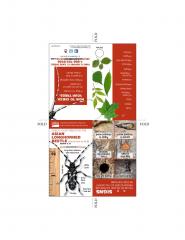Bloom Color: White. Main Bloom Time: Early spring, Late spring, Mid spring. Form: Oval, Upright or erect.
Sorbus aucuparia is a deciduous Tree growing to 15 m by 7 m at a medium rate.
It is hardy to zone 2 and is not frost tender. It is in flower from May to June, and the seeds ripen from August to September. The species is hermaphrodite and is pollinated by Insects.
It is noted for attracting wildlife.
Suitable for: light , medium and heavy soils, prefers well-drained soil and can grow in heavy clay soil. Suitable pH: acid, neutral and basic soils and can grow in very acid and very alkaline soils.
It can grow in semi-shade or no shade. It prefers moist soil. The plant can tolerate maritime exposure.
It can tolerate atmospheric pollution.
Landscape Uses:Specimen. Succeeds in most reasonably good soils in an open sunny position. Grows well in heavy clay soils. Tolerates some shade, though it fruits better in a sunny position. Prefers a cool moist position and a lighter neutral to slightly acid soil. Dislikes shallow soils or drought. Succeeds on chalk or acid peats. A very wind firm tree tolerating very exposed and maritime positions. Tolerates atmospheric pollution. Some named varieties have been developed for their improved fruits which are larger and sweeter than the type. Plants, and especially young seedlings, are quite fast growing. The fruit is very attractive to birds. 28 species of insects are associated with this tree. Responds well to coppicing. Plants are susceptible to fireblight. Special Features:Not North American native, Attractive flowers or blooms. The plant is heat tolerant in zones 7 through 1. .
At this temperature, many plants begin to suffer physiological damage. Heat Zones range from 1 to 12 .
For example Heat Zone. 11-1 indicates that the plant is heat tolerant in zones 11 through 1.) For polyculture design as well as the above-ground architecture information on the habit and root pattern is also useful and given here if available. The plant growth habit is a standard with a non-suckering single trunk .
Habitatsscrub and mountain rocks
Habitatsmainly on lighter soil
Habitatsrare or absent on clays or soft limestones. It is found at higher elevations than any other native tree.
HabitatsWoodland Garden Canopy
HabitatsWoodland Garden Canopy
Resources
ALB Handout Card

HOW TO CHECK YOUR TREES:
• Take 10 minutes
• Look for signs of
the beetle
• Report any sightings
• August is Tree
Check Monthhttps://www.aphis.usda.gov/pest-disease/alb/uploads/2015/07/ALB-Handout-Card.pdfALB Handout CardALB Handout Card
HOW TO CHECK YOUR TREES:
USDA APHIShttps://www.aphis.usda.gov/pest-disease/alb/uploads/2015/07/ALB-Handout-Card.pdf
• Take 10 minutes
• Look for signs of
the beetle
• Report any sightings
• August is Tree
Check MonthALB Handout Card
HOW TO CHECK YOUR TREES:
USDA APHIShttps://www.aphis.usda.gov/pest-disease/alb/uploads/2015/07/ALB-Handout-Card.pdf
• Take 10 minutes
• Look for signs of
the beetle
• Report any sightings
• August is Tree
Check MonthEAB GreenMenace reprint June09

Figure 2—S-shaped tunnels, made by EAB larvae,
riddle infested ash trees.
T
he emerald ash borer (EAB) is a very small buthttp://www.aphis.usda.gov/publications/plant_health/content/printable_version/E…EAB GreenMenace reprint June09EAB GreenMenace reprint June09
Figure 2—S-shaped tunnels, made by EAB larvae,
USDA APHIShttp://www.aphis.usda.gov/publications/plant_health/content/printable_version/E…
riddle infested ash trees.
T
he emerald ash borer (EAB) is a very small butEAB GreenMenace reprint June09
Figure 2—S-shaped tunnels, made by EAB larvae,
USDA APHIShttp://www.aphis.usda.gov/publications/plant_health/content/printable_version/E…
riddle infested ash trees.
T
he emerald ash borer (EAB) is a very small but
Minor pests
- Aporia crataegi
Apple chlorotic leaf spot virus
Apple stem grooving virus
Armillaria mellea
Armillaria ostoyae
Caliroa cerasi
Fomitopsis pinicola
Heterobasidion annosum
Heterobasidion annosum sensu lato
Leucoptera malifoliella
Lymantria monacha
Neonectria ditissima
Operophtera brumata
Orgyia antiqua
Pandemis cerasana
Phytophthora megasperma
Rhagoletis pomonella
Rosellinia necatrix
Saturnia pavonia
